You’ll achieve complete creative control over your artistic vision when you facet rare gems yourself, experimenting with unique cuts and arrangements that showcase each stone’s natural beauty. Mastering the five Ps—proportion, positioning, pointing, polishing, and performance—lets you prioritize brilliance over weight retention while creating investment-quality pieces worth thousands more than commercial alternatives. Each cut becomes uniquely personal, reflecting your individual skill and artistry. This transformative journey from rough crystal to finished gem creates deeper connections and appreciation that textbooks simply can’t provide.
Unleash Your Creative Vision Through Custom Gem Cutting

When you take control of the gem cutting process, you’re not just shaping stone—you’re bringing your artistic vision to life through precise angles, custom facets, and creative cuts that showcase each gem’s unique character.
You’ll make artistic decisions about shape and facet arrangements that enhance each stone’s distinctive properties. Whether you’re experimenting with round brilliant cuts or developing entirely unique styles, gem cutting lets you tailor every aspect to your creative vision.
Mastering the Five Ps—proportion, positioning, pointing, polishing, and performance—ensures your custom cuts reflect your personal artistic style while maintaining stunning brilliance.
The Five Ps of gem cutting—proportion, positioning, pointing, polishing, and performance—transform your artistic vision into brilliant reality.
You’ll transform rough stones into one-of-a-kind pieces that capture your aesthetic preferences and maximize each gem’s natural beauty.
Master the Art of HAI: Height, Angle, and Index Control
You’ll achieve exceptional results when you master the HAI Triangle Lock technique, which synchronizes height, angle, and index measurements for each facet cut.
Your precision depth control becomes the foundation for creating consistent light paths throughout the gemstone’s structure.
This systematic approach delivers ideal light performance by ensuring every facet works together to maximize brilliance and fire in your finished gem.
HAI Triangle Lock
Because precision determines the difference between a mediocre gemstone and a breathtaking masterpiece, you must master the HAI triangle lock—the foundational technique that controls Height, Angle, and Index in gem faceting.
This essential system guarantees you’ll achieve ideal facet cuts every time.
Height controls your facet depth, creating uniform cuts that maximize brilliance while minimizing material loss.
You’ll need precise angle adjustments to determine the exact cutting plane, directly affecting how light reflects and refracts through your stone.
Index placement positions each facet around the gem’s outline, guaranteeing perfect symmetry.
Professional gem cutters rely on HAI triangle lock mastery to achieve the Five Ps: Proportion, Positioning, Pointing, Polishing, and Performance.
When you control these three variables simultaneously, you’ll create visually stunning gems with exceptional light performance and aesthetic appeal.
Precision Depth Control
Precision depth control transforms your understanding of the HAI triangle lock into measurable results that separate amateur work from professional-grade gemstones.
When you master the Height component, you’re controlling how deeply each facet is cut into your stone’s surface. This isn’t just about following measurements—you’re actively managing how light enters and exits your gem.
Every adjustment you make affects the gemstone’s optical performance. Too shallow, and you’ll lose brilliance. Too deep, and light escapes through the bottom rather than reflecting back to the viewer. Your precision depth control guarantees each facet reaches exactly the right depth for maximum light return.
When your gemstone is cut with consistent depth measurements across all facets, you create the uniform surface angles that produce professional-grade scintillation and fire.
Optimal Light Performance
When you achieve mastery over HAI control, you’re orchestrating a symphony of light that transforms ordinary rough material into extraordinary gemstones.
As a skilled gem cutter, you’ll discover that height determines your facet depth, directly controlling brilliance and sparkle by guiding light’s journey through the stone.
Angle precision becomes your secret weapon for maximizing reflection and refraction, creating that coveted light return that makes observers gasp.
Index control guarantees perfect facet placement around your gem’s outline, delivering the symmetry that separates amateur work from professional results.
Together, these three elements create exceptional optical performance that enhances your rare gemstone’s natural beauty, making every cutting session incredibly rewarding and profitable.
Transform Raw Crystals Into Personalized Treasures
As you hold a rough crystal in your hands, you’re looking at pure potential waiting to be released through the art of faceting. Each piece of gem material tells its own story, and you’re the author who’ll transform it into something extraordinary.
When you cut your own gems, you’re creating personalized treasures that reflect your artistic vision. You’ll optimize each stone’s natural characteristics while working around inclusions to preserve maximum value.
| Aspect | Raw Crystal | Your Vision | Final Result |
|---|---|---|---|
| Shape | Natural form | Custom design | Unique cut |
| Light | Basic reflection | Calculated angles | Maximum brilliance |
| Value | Material worth | Added craftsmanship | Enhanced beauty |
| Character | Hidden potential | Personal touch | Artistic expression |
You’ll develop deep understanding of refractive properties while creating one-of-a-kind pieces.
Achieve Superior Brilliance Over Commercial Cuts
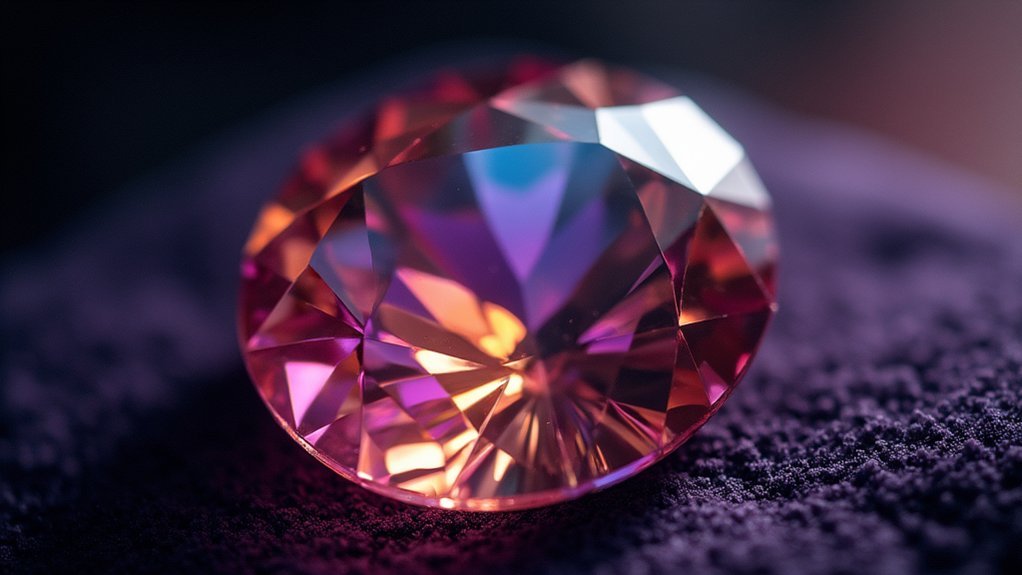
While commercial cutters rush through production to maximize profits, you’ll take the time needed to achieve true optical excellence. When each facet is cut by hand, you’re prioritizing brilliance over weight retention—something commercial operations rarely do.
You’ll master the Five Ps: Proportion, Positioning, Pointing, Polishing, and Performance, ensuring every angle maximizes light return.
Commercial cuts often compromise optical performance for size conformity, but you’ll align each facet meticulously to optimize light reflection and refraction. Understanding light behavior becomes essential—ideal cuts channel light effectively through the stone’s top, while shallow or deep cuts misdirect it.
Ideal cuts channel light perfectly through the crown, while shallow or deep cuts scatter light and diminish brilliance.
The round brilliant cut exemplifies this principle, using precise facet placement to enhance visual appeal and achieve superior sparkle that mass-produced gems simply can’t match.
Develop Precision Skills With the Five Ps of Gemstone Cutting
Before you can achieve the optical excellence that separates handcrafted gems from machine-cut stones, you’ll need to master the Five Ps of gemstone cutting—a systematic approach that transforms rough material into brilliant finished gems.
Proportion forms your foundation: maintain a 1/3 top, 2/3 bottom ratio for ideal light performance.
Positioning comes next—orient your rough gemstones to hide inclusions while maximizing visual impact.
Pointing demands absolute precision as facet edges and intersections must align perfectly for superior symmetry.
Polishing delivers the final critical element, creating mirror-smooth surfaces that dramatically enhance light reflection.
Performance ties everything together—each facet must contribute to overall brilliance and aesthetic appeal.
Master these fundamentals, and you’ll consistently produce gemstones that outshine commercial alternatives.
Build Your Professional Faceting Equipment Setup
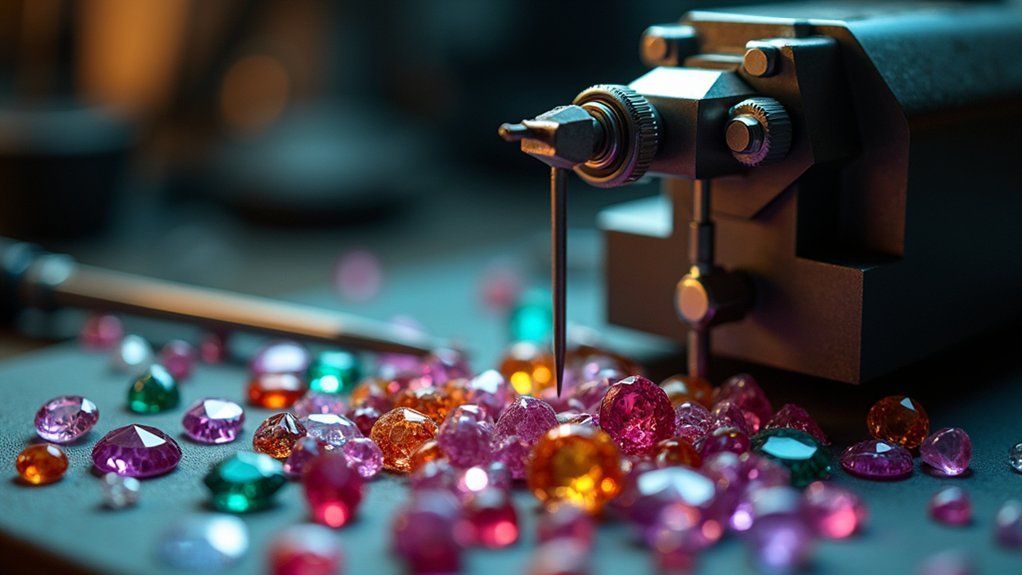
Building a professional faceting setup requires five essential components that’ll transform your workspace into a precision cutting environment.
Your faceting machine serves as the foundation, enabling accurate and efficient gemstone cutting. You’ll need abrasive laps with varying grits, from rough cutting to fine polishing, to achieve professional results.
A dopstick paired with reliable two-part epoxy secures your gems during the cutting process. The properly adjusted mast and quill work alongside an index wheel to determine precise facet angles and positions.
Finally, investing in a dichroscope enhances your ability to distinguish pleochroic colors, maximizing each gem’s visual appeal.
This equipment combination guarantees you’re equipped to handle rare gemstones with professional precision and achieve stunning results.
Navigate the Risks and Rewards of Cutting Rare Stones
Having the right equipment sets you up for success, but cutting rare gemstones presents a high-stakes challenge where one wrong move can destroy thousands of dollars worth of material.
One misstep while cutting precious gemstones can instantly destroy thousands of dollars worth of rare material.
When you’re working with precious stones like Tanzanite, invisible stress fractures can turn into devastating cracks from the heat generated during preforming.
You’ll need to balance artistry with technical precision to preserve each gem’s integrity while maximizing its brilliance.
The risks you’ll face include:
- Hidden stress fractures that can cause shattering during cutting
- Heat damage from improper preforming techniques
- Light leakage from incorrect angles and proportions
- Reduced yield from poor planning and execution
- Complete loss of valuable rough material from inexperienced cuts
However, mastering these techniques transforms rough stones into stunning, unique pieces that can greatly increase in value.
Maximize Light Return Through Proper Angle Techniques
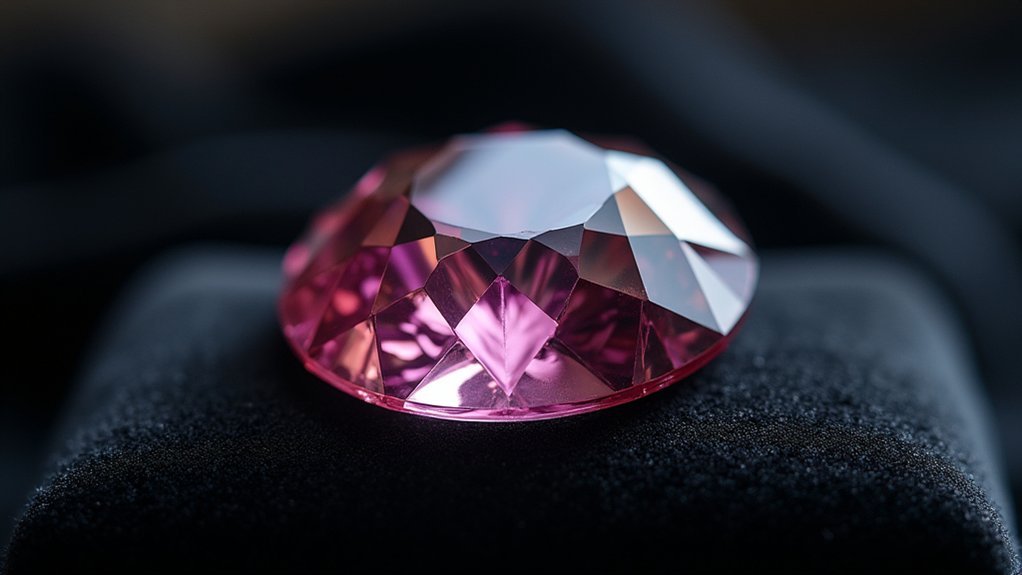
When light enters your gemstone at the wrong angle, it escapes through the sides or bottom instead of reflecting back to create that coveted sparkle.
You’ll need to master precise cutting angles based on your stone’s refractive index. For round brilliant cuts, aim for 34.5 degrees on the crown and 40.6 degrees on the pavilion. Shallow cuts misdirect light downward, while deep cuts leak light sideways—both kill your gem’s brilliance.
Position your facets around these critical angles to channel light back through the top. Each properly executed facet becomes a mirror that enhances performance.
When you nail these angles, you’re mastering proportion, positioning, pointing, polishing, and performance—the Five Ps that transform rare stones into stunning gems with maximum light return.
Preserve Gem Value While Managing Natural Inclusions
Perfect angles mean nothing if inclusions ruin your gem’s clarity and tank its value. You need strategic inclusion management to preserve your gem’s worth while maintaining its natural character.
Smart inclusion handling transforms potential flaws into value-preserving features:
- Assess before cutting – Identify which inclusions can stay versus those that must go
- Strategic positioning – Hide problematic inclusions in less visible areas during faceting
- Selective removal – Target only the worst inclusions to minimize weight loss
- Turn flaws into features – Position interesting inclusions as unique characteristics
- Plan your approach – Map inclusion locations before making any cuts
Understanding inclusion types and their market impact lets you maximize your gem’s potential.
You’ll preserve natural beauty while eliminating value-destroying flaws, creating a superior finished stone.
Connect With the Global Gemstone Cutting Community
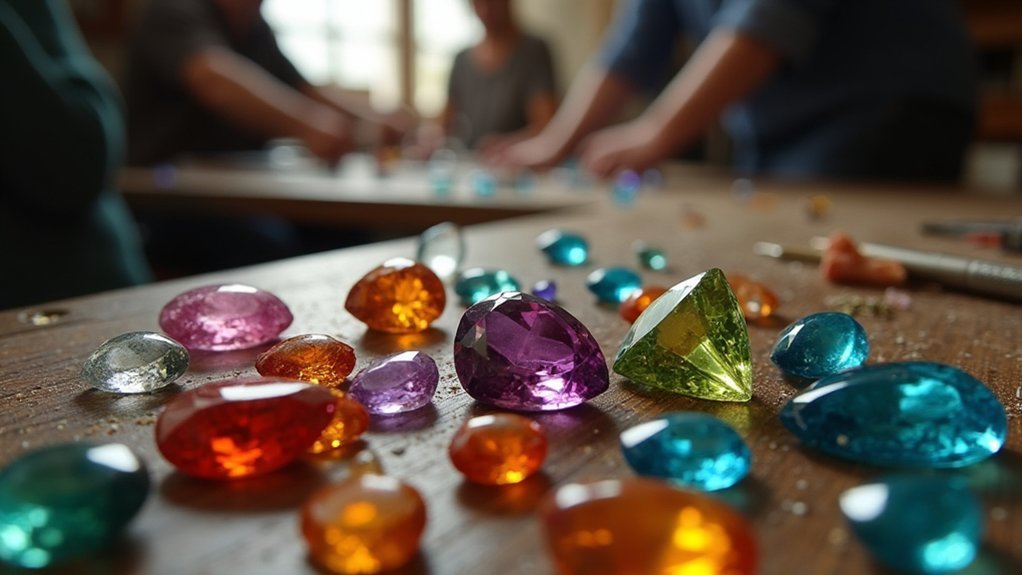
Why cut gems in isolation when you can tap into a worldwide network of experts who’ve mastered techniques you’re still learning?
Joining the International Gem Society connects you with experienced cutters who share cutting techniques and gemstone identification tips through forums and articles. You’ll discover insights about unique specimens like Tanzanian corundum and Nigerian gemstones while learning about specialized tools like dichroscopes for understanding pleochroism.
Community discussions reveal best practices for faceting that you won’t find elsewhere.
Beyond online networking, attending local gem shows and workshops provides hands-on experience with fellow enthusiasts. These connections open doors to advanced techniques and troubleshooting methods that transform your gemstone cutting from hobby to expertise through shared knowledge and mentorship opportunities.
Create Investment-Quality Stones Through Expert Craftsmanship
You’ll transform raw gems into investment-grade stones by mastering three critical elements that separate amateur work from professional-quality results.
Expert craftsmanship requires you to maximize light performance through precise angle calculations, preserve every possible carat while maintaining ideal proportions, and establish rigorous quality standards that guarantee consistent excellence.
These foundational skills determine whether you’re creating a beautiful hobby piece or a valuable gemstone that appreciates over time.
Maximize Light Performance
When you’re faceting rare gems, expert craftsmanship becomes the foundation that transforms raw stones into investment-quality treasures.
To maximize light performance when you cut gemstones, you’ll need to master precise techniques that control how light enters, travels through, and exits your stone.
Understanding your gem’s refractive index allows you to tailor cutting approaches that enhance brilliance and fire.
The Five Ps guide your process:
- Proportion – Calculate ideal angles for maximum light return
- Positioning – Place facets strategically for enhanced sparkle
- Pointing – Guarantee precise facet meets for seamless light flow
- Polishing – Create mirror-like surfaces for ideal reflection
- Performance – Achieve superior visual effects through expert execution
This meticulous approach guarantees your faceted gems exhibit their full potential, greatly boosting market value.
Preserve Carat Weight
Although carat weight preservation might seem secondary to achieving peak light performance, strategic planning during the faceting process enables you to retain maximum weight while creating investment-grade stones.
When you preserve carat weight through expert craftsmanship, you’re maximizing your gemstone’s market value while maintaining its optical brilliance.
Custom faceting techniques allow you to minimize weight loss from rough stones, ensuring more original carat weight remains intact.
By understanding the Five Ps—proportion, positioning, pointing, polishing, and performance—you’ll create stones that balance weight retention with exceptional light return.
Hand-cutting gives you precise control over every angle, letting you work around inclusions and natural formations to preserve carat weight effectively.
This strategic approach transforms unique rough gemstones into investment-quality pieces that command premium prices.
Control Quality Standards
Since investment-quality gemstones demand flawless execution at every stage, controlling your own quality standards through expert craftsmanship becomes the defining factor between ordinary stones and exceptional specimens.
When you facet rare gems yourself, you’re applying GG (Graduate Gemologist) principles to guarantee every cut meets professional standards.
The Five Ps of gemstone cutting give you complete control over quality:
- Proportion – Optimize dimensions for maximum brilliance
- Positioning – Strategic placement of inclusions to preserve integrity
- Pointing – Precise facet junctions for superior light performance
- Polishing – Flawless surface finish enhancing visual appeal
- Performance – Maximum light return through controlled angles
You’ll create stones that prioritize artistry over weight retention, resulting in unique specimens that attract collectors and maintain market value through superior craftsmanship.
Experience the Transformation From Rough to Finished Gem
The metamorphosis begins the moment you position a rough crystal on your faceting machine and make that first decisive cut. When you experience the transformation from rough to finished gem, you’re witnessing nature’s raw beauty evolve into calculated brilliance.
Each facet you create reveals new dimensions of light and color that were hidden within the stone’s crystalline structure.
This hands-on process teaches you what no textbook can convey. Even a GG (Graduate Gemologist) benefits from the tactile knowledge gained through actual cutting.
You’ll develop an intimate understanding of how inclusions behave under pressure and how crystal orientation affects the final result.
The journey from cloudy rough to sparkling masterpiece creates an unbreakable bond between you and your gemstone, making each piece uniquely yours.
Frequently Asked Questions
Is It Hard to Facet Gemstones?
You’ll find gemstone faceting moderately challenging initially. While you can learn basic techniques quickly, mastering precise angles, operating faceting machines, and achieving brilliant results requires years of dedicated practice and experience.
What Do You Call Someone Who Facets Gems?
You’d call someone who facets gems a “faceter” or “gem cutter.” These skilled artisans use specialized faceting machines to create precise angles that maximize a gemstone’s brilliance and beauty through expert cutting techniques.
Are Faceted Gemstones Real?
Yes, you’ll find faceted gemstones are absolutely real. When you facet a stone, you’re simply cutting and polishing its surface to enhance brilliance without changing its fundamental composition or authenticity.
How Much Does It Cost to Facet a Gem?
You’ll pay $50 to $500 for professional gem faceting, depending on complexity and stone type. Alternatively, you can invest $300 to $3,000 in your own faceting machine plus additional tools.
In Summary
You’ll discover that faceting rare gems yourself transforms you from a collector into an artist. Through mastering HAI techniques and the Five Ps, you’re creating investment-quality stones that reflect your unique vision. You’re not just cutting gems—you’re preserving their natural beauty while maximizing brilliance beyond commercial standards. Each rough crystal you transform connects you to a global community of craftspeople who understand the magic of this ancient art.

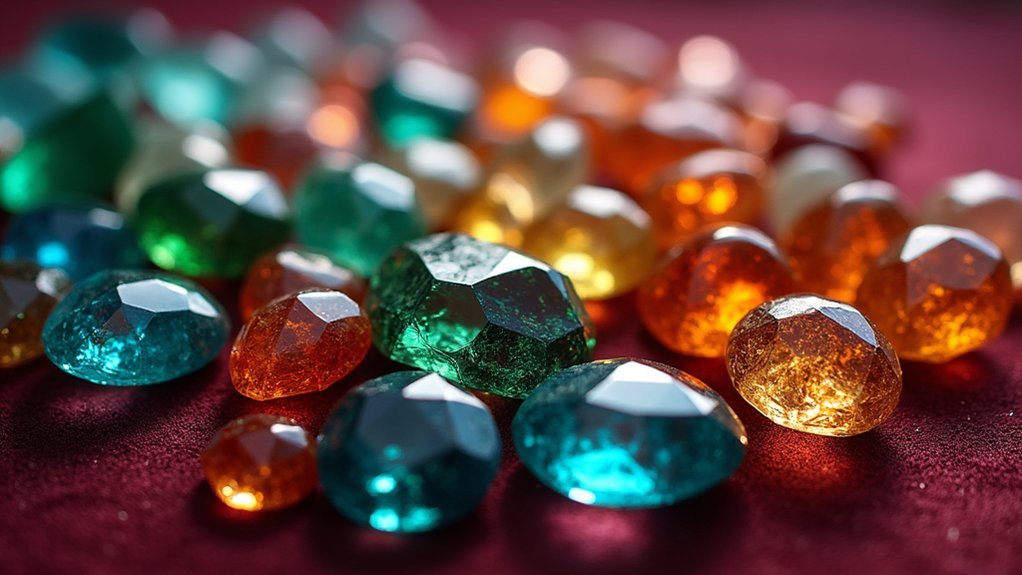

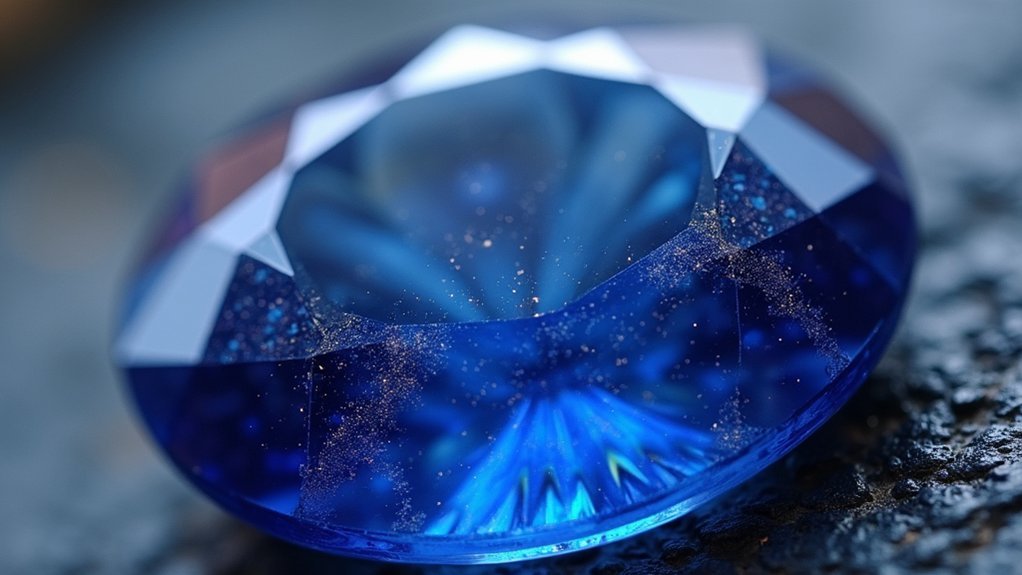
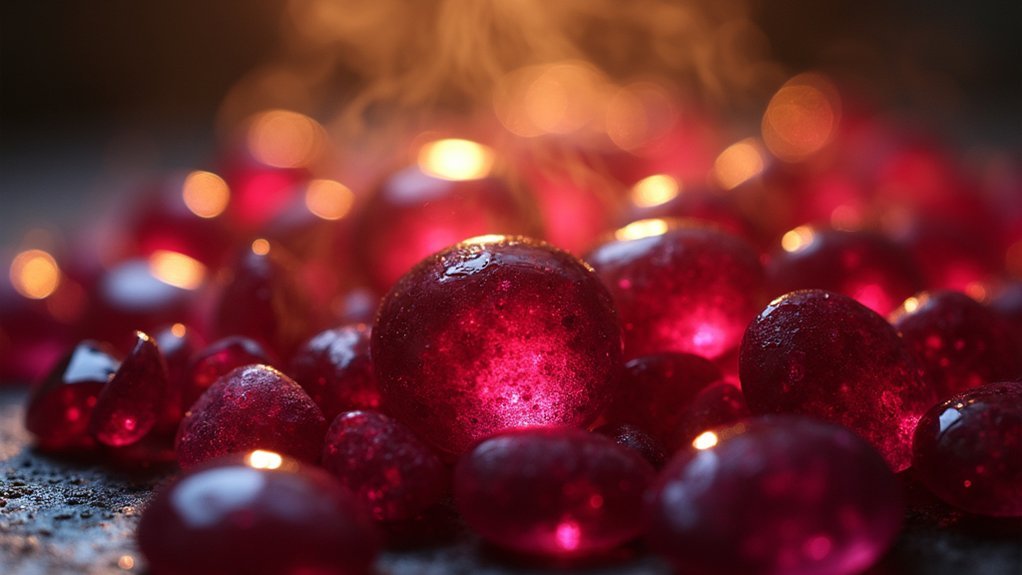
Leave a Reply